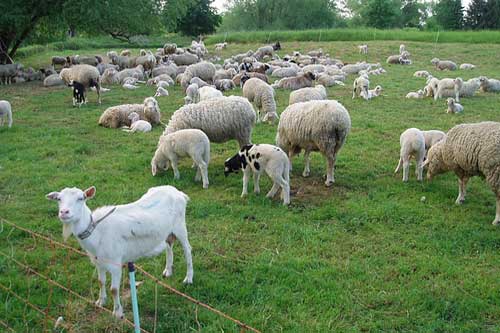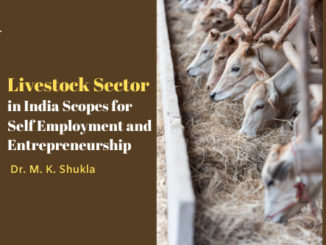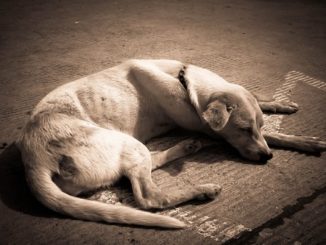Introduction
India is blessed with the most fabulous livestock wealth in the world. Animal husbandry and livestock production is the backbone of the Indian agriculture and plays an important role in the rural economy by providing employments, livelihood and food security to the rural population. Sheep and goat are the most important livestock in arid, semi-arid and mountainous regions where crop and dairy farming are not economically feasible. These are the principal livestock contributing to the livelihood of a 70-80% of small & marginal farmers and landless labourers. According to 20th livestock census 2019, the total sheep in the country is 74.26 Million increased by 14.1% over previous Census.

Pregnancy toxemia
This is a metabolic disease and also known as Preparturient Paralysis, Lambing paralysis, Twin lamb disease, Twining kid diseases, Twinning Disease, Pregnancy ketosis, Sleepy sickness, Ante partum paralysis. This is a highly fatal metabolic disease.
Causes
Common disease of ewes in the last 6 weeks of pregnancy and immediately after lambing. During late pregnancy, the ewe has a very high energy requirement to provide for her own needs and the growth of the lamb or lambs she is carrying. If the energy requirement is not met by feed intake, the ewe will break down her own body tissues. Negative energy balance & females carrying multiple foetuses are more prone. If the rate at which the ewe breaks down her tissues is too rapid, toxic wastes from the breakdown process accumulate and pregnancy toxaemia occurs.
Symptoms
The initial signs are dullness and loss of appetite and affected sheep lagging behind the mob when driven. Later the ewe will stand alone, appear dopey and will not move when approached. If driven the ewe will appear blind, stumble and go down. A sheep may adopt a posture keeping the head in elevated direction with erect ears as if listening higher sound. Star -gazing posture may be noted. The ewe will eventually sink into a coma and die within 5-7 days.

Diagnosis
- Based on history of pregnancy, inadequate amount of grain feeding.
- Detection of ketone bodies in urine and blood glucose below 25 mg/dl.
Differential Diagnosis: Milk fever and louping ill. On post mortem, the liver is generally tan to yellow in colour and is quite soft and there is often plenty of fat on the carcass.
Treatment
- Successful treatment of pregnancy toxemia requires early detection and steps to quickly meet the energy (glucose) needs of the affected ewe. The most common treatment is to drench ewes with 2 to 3 ounces of propylene glycol 2 to 3 times daily. Yogurt mixed with water will also provide energy and bacteria to stimulate the rumen. Intravenous glucose is another possibility, but harder for producers to do on the farm.
- Mild cases: treated with hand feeding of grains and administrating oral propylene glycol (60 ml) orally twice a day.
- Severe cases: 200 ml of 5% Dextrose through I/V route along with 40 IU of insulin SC.
- Animals with recumbency should be treated with antibiotics, 25 mg dexamethasone, 3 litre 5% Dextrose with bicarbonate.
- Advanced cases; may require an emergency caesarean section (administering 15-20 mg of dexamethasone I/V).
Nutritional management
- Force feeding and/or injections of multiple B vitamins can help stimulate the ewe’s appetite. Antibiotics can be administered to prevent pneumonia. In advanced cases, a caesarian section may need to be performed to remove the fetuses and save the ewe’s life.
Of course, like other diseases, it makes more sense to prevent pregnancy toxemia than to treat it. To achieve this, it is absolutely essential that ewes be provided adequate energy in their ration during the last 4 to 6 weeks of gestation. Good quality hay should be provided, along with grain supplementation, beginning at 200 gm and increasing to 500-700 gm per head per day until the time of parturition. - Grain and molasses are excellent sources of energy. Minimum change of feeds should be made during advanced pregnancy.
- Hay alone usually doesn’t provide enough energy for ewes carrying twins and triplets. Exercise is also deemed important in the prevention of pregnancy toxemia.
- Abrupt feed changes must also be avoided, and ewes should not be stressed during late pregnancy. There must be adequate feeder space so that all ewes can fit around the feeders and get their fair share of hay and grain. Producers should strive to have ewes in moderate body flesh (condition score of 3+) prior to lambing. Ewes should be prevented from becoming obese during early pregnancy, and thin ewes should be separated and receive extra feed until they achieve the desired condition score. Ewes and does should be placed under such diets so that they do not become over fat.
- Care should be taken to avoid over stress and fasting during late gestation.
- Vitamin A rich feed during gestation period., Adequate water should be provided to the animal.
- Deworming should be done induction of pregnancy, Animal should be kept away from sun and hot.
|
The content of the articles are accurate and true to the best of the author’s knowledge. It is not meant to substitute for diagnosis, prognosis, treatment, prescription, or formal and individualized advice from a veterinary medical professional. Animals exhibiting signs and symptoms of distress should be seen by a veterinarian immediately. |






Be the first to comment